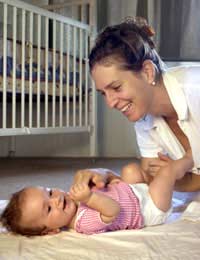Hip Dysplasia in Babies

As expectant parents await the arrival of their babies, it is common for them to look forward to romping and playing with their little ones. Most of the time, babies come into the world healthy and are soon able to keep their parents busy chasing them about. Sometimes, however, children are subject to conditions which affect their mobility, as in the case of those with hip dysplasia.
What is Hip Dysplasia?
Hip dysplasia, sometimes referred to as hip dislocation, can be categorised as either congenital, meaning present at birth, or developmental, which refers to cases that develop over time, usually within the first year of life. While there is some professional disagreement on some of the specifics about hip dysplasia, there are some commonly agreed upon points. Hip dysplasia is the result of an abnormal development of the hip in relation to the femur (thigh bone) and the acetabulum, which is the cuplike socket that connects the femur and the pelvis. Ideally, by the time that a baby is born, the femur should be located in the centre of the acetabulum with the socket covering the head of the femur. In cases of dysplasia, the femur lies unnaturally out of the socket.Diagnosing Hip Dysplasia
Sometimes, hip dysplasia is noticed immediately during the initial examination of a newborn, but often, a diagnosis is made a few weeks later at a follow up visit. Doctors rotate the hip joints of babies during regular exams, looking for signs of improper placement. Often parents are made aware of a possible problem within their baby's first six weeks of life, but paediatricians continue to check for developmental abnormalities of the hip again at an eight month check up.What is the Treatment?
Children who are diagnosed with hip dysplasia are often subjected to at least one corrective surgical procedure, with some requiring additional surgeries to achieve optimal results. The goal of the orthopaedic surgery is to return the hip joint to its normal alignment, hopefully preventing the onset of premature osteoarthritis. The medical community is in general agreement that the earlier in life the corrective procedures are made, the better the chances of a positive result, so in most cases, surgical patients in hip dysplasia cases are babies or young children.What About Recovery?
After undergoing a surgical correction of the hip/femur/acetabulum relationship, young patients are placed into hip spica casts which go from the chest all the way down to the ankles, with the child's legs held at right angles. A bar is held in place between the legs to help secure the proper positioning of the legs and hip joints. While necessary, the casts are heavy and can make it very difficult for parents and other caregivers to transport children, rendering some families of hip dysplasia patients virtually housebound for a number of months. In cases where more than one surgery is required, recovery and time spent immobilised in casts is even greater.Obviously, it is important for children with hip dysplasia, as well as their families, to be afforded as normal a schedule as possible during the recovery period. All children (all people, for that matter) benefit from social interaction and regular outings, so the support and assistance of caring friends and family members can be invaluable to the recovery process. While surgery can assure the healthy development of the physical condition, care must be taken to be sure that the child's need for emotional and intellectual stimulation are not put on hold, waiting for the removal of their casts. Parents of children going through the healing process are often their best advocates, actively seeking the needed government mandates that can help their children, and others who have conditions which limit their mobility, to live full and active lives.


Re: Ultrasounds - What is EFBW and GMS?
My wife is 32.6 weeks ...and the babys weight is 1971gms...is that normal or not...please reply me.....
Re: Ultrasounds - What is EFBW and GMS?
my 18th week and baby weight 252 it is gud or bad...please tell me....
Re: Ultrasounds - What is EFBW and GMS?
Hello!i have 21 weeks and 4 days pregnancy.. and my EFBW is 430gms.. is that normal?? Will my baby healthy or not??
Re: Abdominal and Pelvic Pain During Pregnancy
Left pelvic pain, backpain pregnency positive' is any problem, already ectopic happen
Re: Ultrasounds - What is EFBW and GMS?
My wife is 21 week 2 day . In scan report EFRW 415 GM is normal or not . Can you please help me to know current status of…
Re: Ultrasounds - What is EFBW and GMS?
I am 34.1wks pregnant my baby weight is 2215gm is my baby healthy
Re: Ultrasounds - What is EFBW and GMS?
My wife is 37weeks 5days pregnant E.F.B.W - 3010 grams how is she
Re: Ultrasounds - What is EFBW and GMS?
I am pregnant of 36 week 2 days and my EFBW is 1949 is it normal..?
Re: Ultrasounds - What is EFBW and GMS?
i had my ultrasound rhis sept 19 i wonder what is rhis number for efbw 2336 stands fir can you please give me an idea…
Re: Ultrasounds - What is EFBW and GMS?
my wife is 16.2 weeks and done early tiffa scan. E/O an elongated anechoic lesion with minimal internal echogencity…